
February 22, 2007. The conversion of the Public Gaol was already well underway when Colonial Williamsburg historian—and newly-minted historical film consultant—Cathy Hellier arrived on the set. Just the evening before she had been assigned to help out with the filming of HBO’s “John Adams,” the acclaimed seven-episode series based on David McCullough’s biography of our second president.
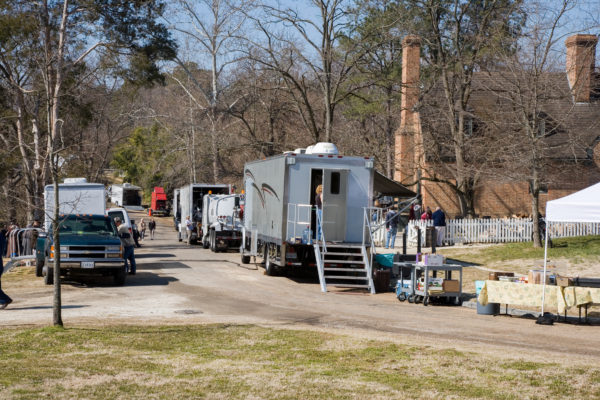
Approaching the gaol, production trucks were lined like a barricade on Nicholson St. A craft services tent was set up nearby to provide snacks and drinks for the crew. Actors and extras milled about.
Several Colonial Williamsburg experts provided support. “None of us knew exactly what the job description was,” recalled Cathy. Fitted with an earpiece and armed with little more than a few cursory introductions, she had to learn on the fly.
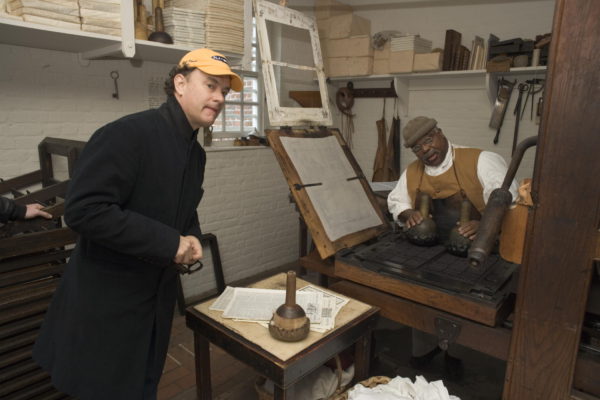
Anticipation had been building since it was officially announced in July 2005 that Williamsburg would provide a historic backdrop for part of the series. Tom Hanks, whose company, Playtone, produced the series, quietly visited during scouting trips.
That first day of production included scenes shot in the Public Gaol, where John Adams was meeting with the British soldiers he was defending for firing on civilians during the Boston Massacre. Later, Bruton Parish Church provided the setting for a town meeting.
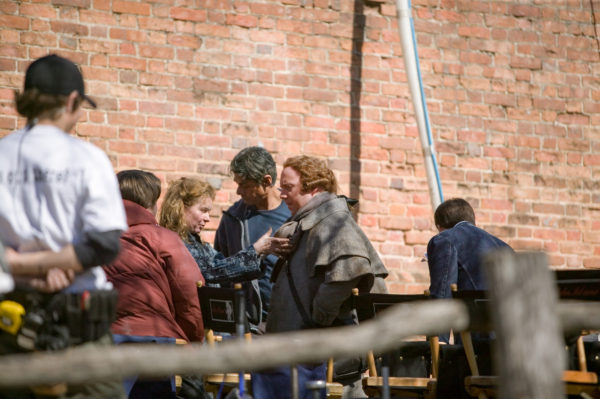
Historic Trades Tailor Mark Hutter helped instruct the men on set in the particulars of period deportment during the first day of shooting. “I taught military hat honors to the actors portraying the imprisoned British officer and soldiers, and a period-appropriate bow to Paul Giamatti,” he recalled.
“This was new to all of them and they had a very short time to practice and make it seem familiar and natural. It was fun to watch them walk around the set randomly bowing to one another, trying not lean forward on their front leg or to make a big theatrical flourish with their hands. It makes me realize how good our interpreters become at portraying the past by adopting period manners.”
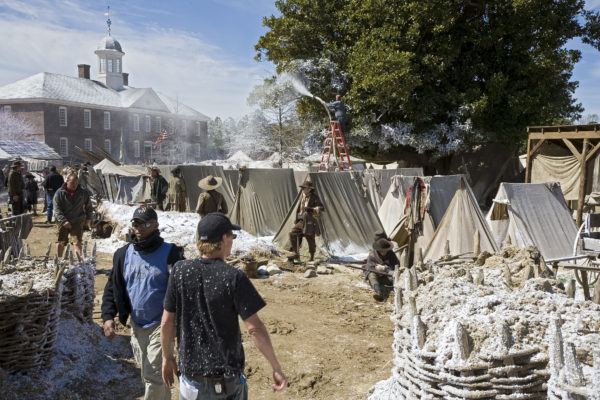
Shooting in Williamsburg continued intermittently into May. In March, the Public Hospital was memorably recast as Harvard Yard—blanketed with (fake) snow, no less. “The fake snow was so cool,” said Cathy. “It was finely-shredded paper that took footprints like real snow.”
She ended up being the one historian who stayed with the John Adams shoot for the duration of its Virginia filming. (Scenes were also shot in other locations, in particular Hungary, which stood in for Paris and London.)
She was quickly fascinated by the politics of the Hollywood set, which she saw brimming with similarities to 18th-century hierarchical etiquette. The director, of course, was at the top. You wouldn’t speak to the director without being asked, for example; nor would you make eye contact.

Cathy provided advice on etiquette, deportment, as well as other issues of historic authenticity. She would tell actors how to stand, for example, or the etiquette of leaving a room. (In the 18th century, “you wouldn’t just turn and walk away.”)
In some large scenes she would run around and help pose people appropriately. Some listened more than others. While a hand stuck in the waistcoat was common enough, the look was dispensed with because it just didn’t look right on film. Cathy called it “the disappearing hand,” and they shifted to alternative postures.
After her expertise on conversational colonial English was discovered as she reviewed a Colonial Williamsburg script, Cathy was asked to take a look at the John Adams dialogue. But there was little to improve in scriptwriter Kirk Ellis’s work, Cathy said, because he had such a good feel for period language.
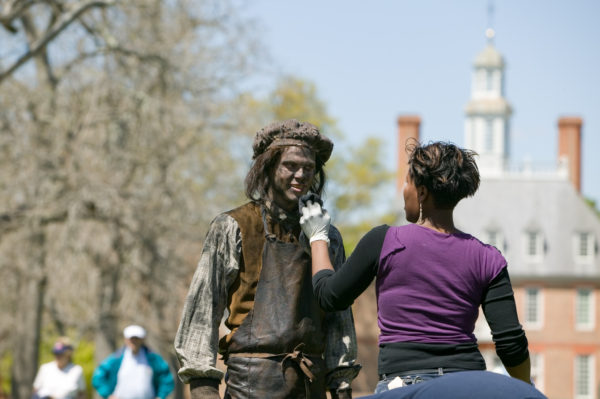
There were a few times when she disagreed with director Tom Hooper on some historical point. “I didn’t always win,” said Cathy. But she appreciated the fact that he listened, and also his attempts to capture visually the 18th century’s grittiness. “He wanted people to look scruffy, not too perfect.”
The gig lasted about three months. Aside from the Williamsburg shoots, Cathy commuted to locations near Richmond. The main sound stage was inside the sprawling former AMF factory in Mechanicsville. Within were sets of all description: Monticello’s interior, the courtroom where Adams defended the soldiers involved in the Boston Massacre, even the interior of a ship, which pitched and heaved on mechanical frame.
“There was always construction of sets going on, so the carpenters would have to stop every time they heard ‘quiet on the set,’” said Cathy.

The days were long, often 12 to 14 hours. In between takes, there were long stretches of waiting, consulting, and just chatting. Laura Linney, who played Abigail Adams, was “very gracious.” David Morse, who played George Washington, would come by to ask questions about deportment. “We worked on his bow and how he would stand, or we would just talk about Washington,” said Cathy.
But Cathy expressed an outsized admiration for Paul Giamatti’s craft and work ethic. “I think he must be one of the hardest working actors on the planet. Every day he had everything down exactly as it was-I don’t know how he did it. And he was super nice. He approached me to ask about what I thought about some of the books he had read to research Adams.”
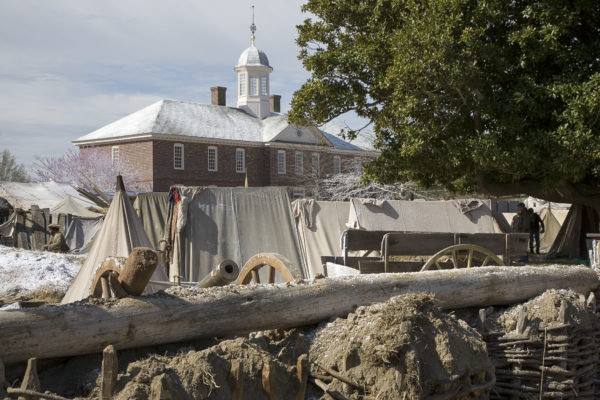
Next time you watch, look for how John Adams’ deportment subtly changes over time as his career progresses. His early diary entries indicated that he was anxious about his deportment, particularly his bow, so he strove to improve how he appeared to others. Tom Hooper and Cathy agreed that Paul Giamatti’s performance and body language should reflect this.
Cathy typically sat with the producers, on director’s chairs, of course, observing the action and looking for anything that didn’t quite look right from a historian’s perspective. About halfway through filming Cathy was presented with her own director’s chair, complete with her name and the John Adams logo, which remains a cherished possession.
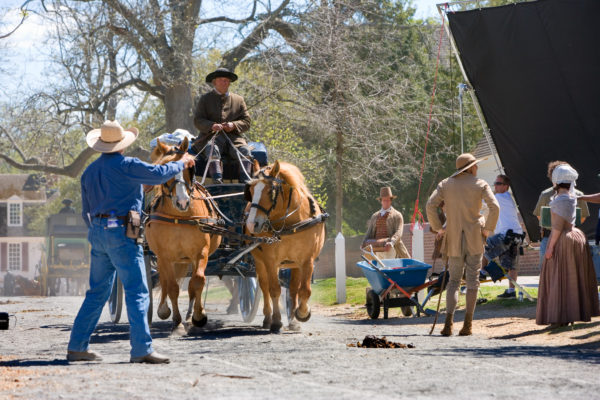
The primary exterior set near Richmond was in the middle of an onion field on the Powhatan County side of the state prison farm. With extensive use of a green screen, the port of Boston rose high up on dry ground. A single ship was repainted multiple times to be used in different scenes. In fact, the set remained in place long enough to be used as City Wharf in present-day Hopewell, Virginia, in Colonial Williamsburg’s 2010 electronic field trip, The Rights of Youth. The prison farm site was also used for the Adams family’s Massachusetts homestead.
A farm near Mechanicsville was used for some Boston and Philadelphia exteriors, including Independence Hall. Night shoots there captured the drama of the Boston Massacre. “When you see Adams running and can see his breath, that’s because it was freezing cold!” said Cathy.
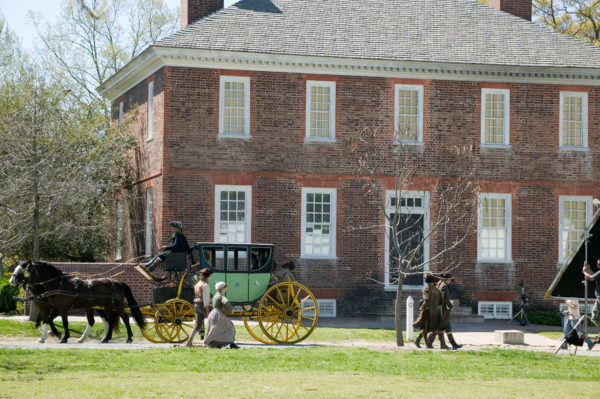
In April the final round of Williamsburg filming featured coffins and a sign warning of a yellow fever outbreak in front of the Wythe House on Palace Green. “Persons in contact with Foreners, or near the city warfs should be vigilant,” it warned, with appropriately idiosyncratic 18th-century spelling.
John Adams was just one of many star turns in Williamsburg. We’ll see who calls next.

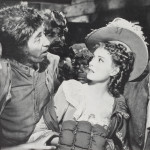
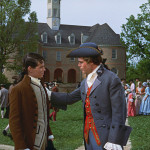
I have to thank Cathy Hellier and all the rest of the CW staff who no doubt helped make this series one of the most authentic I’ve ever seen, right down to the overlapping transitions of men’s fashions to the visible deterioration of the characters’ teeth with age.
Thank you so much for this post!
John Adams is my favorite movie of all time and you just added even more to my enjoyment of it.
We are so lucky to have a living institution such as Willieamsburg to serve as a setting for so many historical dramas. You can’t get more authentic than Colonial WIlliamsburg.